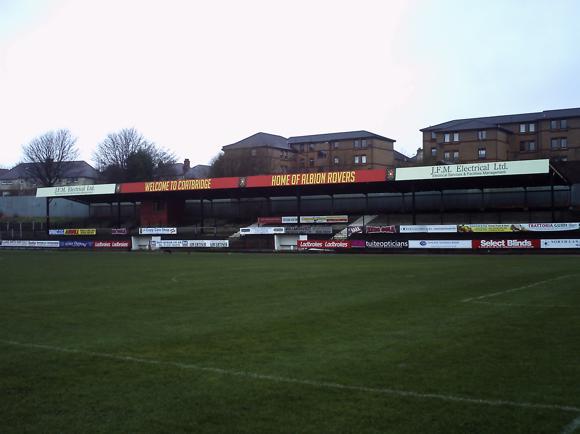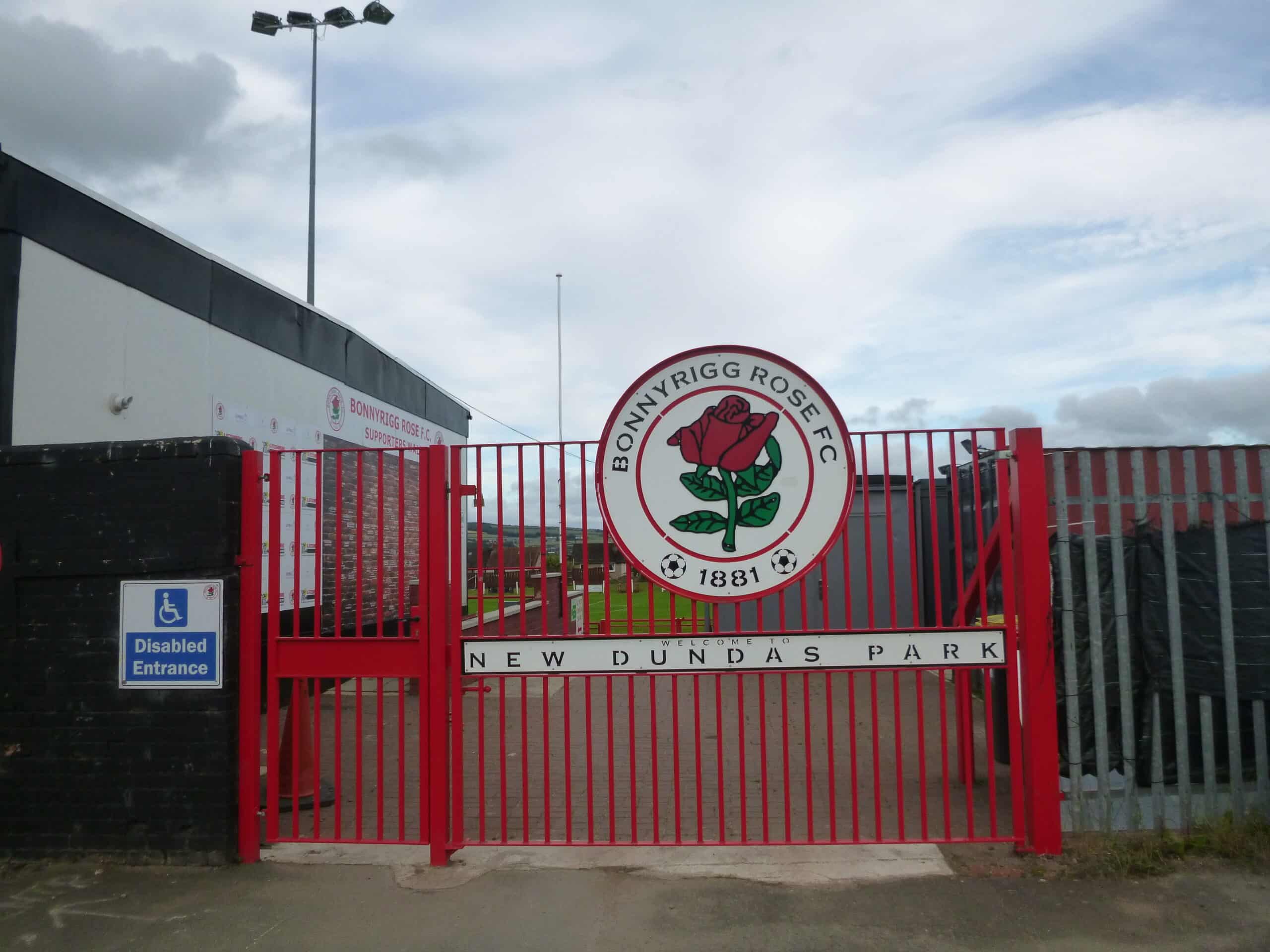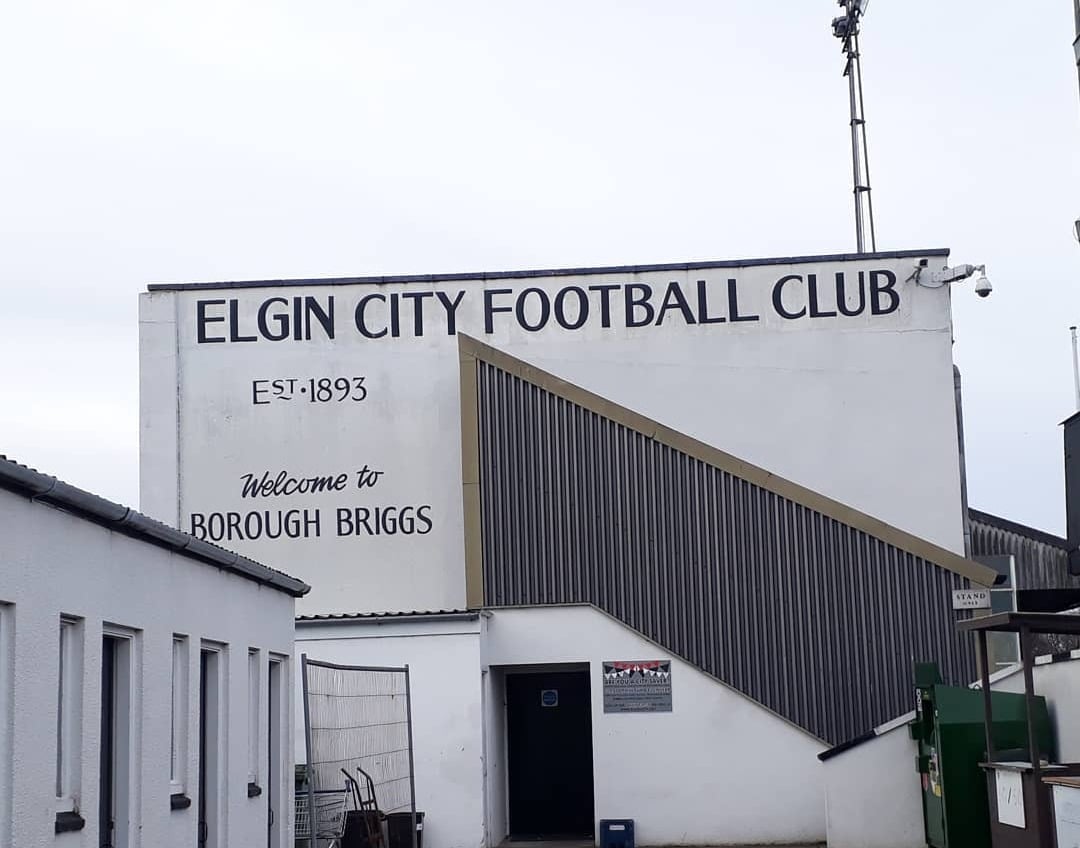A fan’s guide – the club from early doors to today
Relegated from the Scottish League in 2023, Albion Rovers represent the former industrial hub of Coatbridge, ten miles east of Celtic Park.
In over a century of senior football, Rovers’ home of Cliftonhill had seen the occasional promotion campaign, even the odd cup run, but the attraction of top-class football in one of Europe’s biggest club grounds has often drawn the significant local Irish diaspora away from Coatbridge to Glasgow’s East End.
The Wee Rovers had long been considering their own move from Cliftonhill, first to groundshare with local rivals Airdrie, then to a potential new-build in Whifflet. With Lowland League football a prospect for a few seasons to come, that now seems a distant prospect.

Whifflet, south of Coatbridge, was where Albion Rovers played for four decades shortly after their formation in 1882. A merger of Albion FC and Rovers FC, the club joined Scottish Division Two in 1903.
Running out in blue shirts – yellow and red weren’t adopted until 1961 – Rovers stayed at Meadow Park until Cliftonhill opened on Christmas Day, 1919.
The move had been planned for months, the club looking for return to the Scottish League after dropping out in 1915. A park pitch in Whifflet would have not convinced many administrators on Rovers’ suitability for re-accession.
Admission to a single Scottish division coincided with the most successful cup campaign in the club’s history. With Coatbridge-born inside-forward Jock White, later a Scottish cap and regular at Hearts and Leeds, Rovers progressed to a semi-final tie with league leaders Rangers.

A twice replayed fixture culminated in a shock 2-0 win and a final with Kilmarnock in front of 95,000 at Hampden. Urban myth has it that on the day, Rovers goalkeeper Joe Shortt had spent the previous night drunk in a Glasgow jail and club officials hurriedly arranging bail just in time to get the inebriated custodian to the game. Nonetheless, Rovers went ahead before Killie hit back, then triumphed 3-2 over the weary North Lanarkshire side.
Relegated in 1923, Albion Rovers returned to the top tier a decade later, then again in 1948 with later Celtic legend Jock Stein in the line-up.
Another bright spell in the mid 1960s ended with the sale of teenage prodigy Tony Green to Blackpool. The next hero of Cliftonhill was Bernie Slaven, converted from left half to prolific striker by player-manager Andy Ritchie. The Ulsterman’s 31 goals deflected attention from the sponsored Caramel-wafer kit Rovers’ players wore in the mid-1980s.
With money tight and a proposed groundshare with Airdrie ever closer, the club took the radical move of going full-time in 2000. Twice failing narrowly to gain promotion, Rovers soon switched back to semi-pro status.

Reward came in 2011 with play-off wins over Queen’s Park – by two very late goals – and Annan Athletic to reach the Second Division. A hat-trick from Robert Love sealed the home win in the first leg of the final.
Soon relegated, Rovers then bounced back under player/manager Darren Young, a former Scotland under-21 international. His shoestring side won League Two by ten points, then finished two points off a play-off place in League One. Wide man Ally Love, brother of Robert, did the most damage, but was offered to Brechin before the 2016-17 campaign.
With Young still manager, Rovers beat Queen of the South in stoppage time to reach the Fourth Round of the Scottish Cup, and dream tie at home – actually at Airdrie – against Celtic. Defending deep, Rovers recorded one shot and no corners – but kept the champions down to 3-0.
Following relegation to League Two in 2018, Rovers never really recovered and, in truth, had rode their luck to survive in senior football. Awarded three points on a technicality after a defeat to Clyde in 2018-19, saved by the pandemic curtailment of 2019-20, the Coatbridge side were never far from the big drop.
When it came in 2023, it only took a single league point differential from Elgin, who had a far worse goal difference, and a single goal from The Spartans at Cliftonhill in the play-off decider, but the combined effect was a farewell to Scottish senior soccer after 120 years.




ground Guide
The field of dreams – and the story behind it









Right on Main Street, Cliftonhill is a faded, old-fashioned ground, set in a natural bowl with Coatbridge spread out behind. The quaint main stand, crowned by a roof extension protruding towards the touchline, is the only part of the ground in operation, away supporters directed towards its east side – but segregation is relaxed in the Lowland League. Visiting supporters should turn right as they enter.
Opposite, crumbling terracing at least provides a welcome splash of yellow and red amid the drab surrounding residential housing – it’s long been closed.
Capacity is around 1,500, and rarely stretched – 500 seats are set back from the standing terraces that front the main stand. The ground currently goes by the official sponsored name of the Reigart Stadium.
getting here
Going to the ground – tips and timings


Three stations are walking distance to the ground, the nearest being Coatdyke. Veer left along Quarry Street to the junction with E Muiryhall Street. Turn left, then first right at the roundabout, and you pass pre-match bar Owens before reaching the ground. Allow 10mins.
From Whifflet, it’s 15mins. Turn right at the end of the station approach onto Coatbank Street, then right at the third roundabout by McDonald’s. This is Main Street and the ground is 250 metres on the left. It’s also walkable from Coatbridge Central – Main Street is a short stroll from W Canal Street beside the station. Follow it right through town, and its many pubs.
Cliftonhill Stadium has its own stop on the 201 route from Motherwell station (every 20mins, journey time 30mins) via Bank Street/Buchanan Street alongside Coatbridge Central station.
The sat nav code for Cliftonhill is ML5 3RB. The club does not have a car park but there is street parking available in the residential area north of the ground, for example, along Albion Street (ML5 3SB).
getting in
Buying tickets – when, where, how and how much

Pay-on-the-day admission is £11 for the main stand, cash or card payments accepted at the turnstiles. Reduced rates of £6 apply to seniors, the unwaged and 14-17s. Youngsters under 14 get in for £3.
what to buy
Shirts, kits, merchandise and gifts

A modest selection of standard red-and-yellow souvenirs should be out on display on match days – there’s no club shop as such. The current home top feature red diagonal flashes on yellow, red sleeves and collar. Away is a striking black with red tiger stripes over the sleeves and a red collar.
Where to Drink
Pre-match beers for fans and casual visitors






The cluster of pubs and bars close to Whifflet station is handy if that’s where you’re coming in.
Facing the station by the roundabout, Carsons is a standard, homely local with TV football. A short hop down the main road in the opposite direction to the ground, you find the Big Tree, a traditional Irish pub that goes big on televised sport and live music. A little nearer to the station, the Whifflet Arms focuses on food as well as big-screen match action and weekend entertainment.
If you’re coming through Coatbridge, on the stadium side of Main Street, The Vulcan is the Coatbridge Wetherspoons, named after an iron boat on display in the local industrial museum. Diagonally opposite, large, modern Innishmohr puts something on most nights to keep everyone happy – strong selection of beers, too.
Nearer Coatdyke, right on Main Street and the closest watering hole to Cliftonhill, Owen’s, known to all as Big Owen’s, has long served Rovers and away fans – it’s also a sit-down place for meals.
At the ground, a match-day bar sometimes operates behind the main stand.

















































